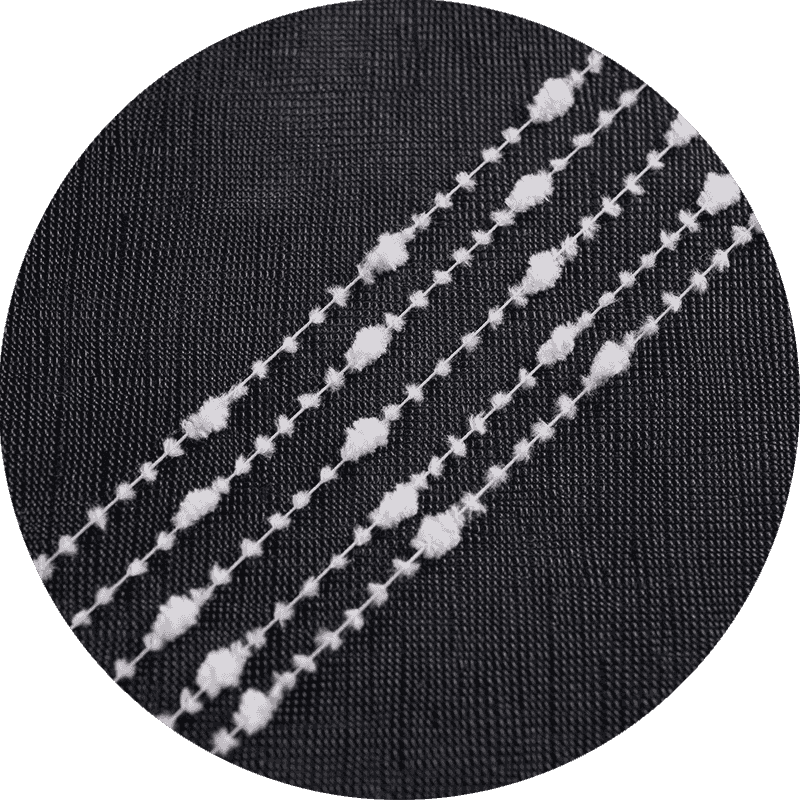Introduction: A Blooming Trend in the Yarn World
In the ever-evolving world of textile fibers, Chrysanthemum yarn has recently attracted attention for its distinct texture and decorative potential. But what exactly is Chrysanthemum yarn? Named for its visual similarity to the soft and layered petals of a chrysanthemum flower, this specialty yarn is characterized by a fluffy, curly, or boucle-like structure that gives fabrics a dynamic three-dimensional look.
Whether you’re in fashion design, home décor, or textile sourcing, understanding this unique yarn can open up new creative and commercial opportunities.
What Is Chrysanthemum Yarn?
Chrysanthemum yarn is a novelty yarn that features a curled, loopy, or puffy texture, often achieved through special spinning or air-texturing processes. The yarn structure resembles the layered petals of a chrysanthemum flower—hence the name. It's usually made from synthetic fibers such as polyester, acrylic, or nylon, but natural fiber versions (like cotton or blends) are also emerging.
Chrysanthemum yarn is not a specific brand but rather a descriptive term for a type of textured yarn that adds volume, softness, and ornamental richness to fabrics.
What Are the Key Features of Chrysanthemum Yarn?
Highly Textured Appearance: The yarn creates a floral, curly, or bubbly surface texture on fabrics.
Soft and Voluminous: Despite being synthetic, it's often lightweight and extremely soft to the touch.
Durable: Polyester-based Chrysanthemum yarns offer excellent abrasion and wrinkle resistance.
Versatile: It can be used alone or blended with other yarns to add aesthetic depth.
Color Retention: Bright and pastel colors dye well and stay vibrant over time.
What Are the Most Common Uses for Chrysanthemum Yarn?
Fashion & Apparel:
Used in knitting and weaving to create outerwear, jackets, cardigans, scarves, and sweaters.
Popular in children’s wear for its soft and fun texture.
Occasionally used for accessories like hats and decorative collars.
Home Textiles:
Ideal for upholstery fabrics, cushion covers, and throw blankets.
Adds visual richness to curtains and decorative pillows.
Crafts & DIY:
Loved by hobbyists for making plush toys, rugs, and textured art projects.
Luxury Applications:
Sometimes combined with metallic yarns or sequins to create fabrics for high-end fashion collections.
Why Is Chrysanthemum Yarn Gaining Popularity?
The textile market is increasingly shifting towards yarns that offer aesthetic novelty and functional comfort. Chrysanthemum yarn checks both boxes:
Visual Appeal: Designers love the three-dimensional structure that elevates ordinary fabrics.
Comfort: Soft and skin-friendly, it’s ideal for close-to-body garments.
Trend Compatibility: Fits well with bohemian, vintage, and textured fashion trends.
Instagrammable Looks: Popular with fashion influencers and textile crafters looking for photogenic textures.
What Are the Advantages and Disadvantages?
| Advantages | Disadvantages |
| Visually rich and decorative | May not be suitable for all climates (can be warm) |
| Soft and cozy texture | Difficult to cut/sew for beginners |
| Durable and wrinkle-resistant | Requires specific washing care |
| Compatible with knitting/weaving | Limited drape for certain applications |
How Does Chrysanthemum Yarn Compare to Bouclé or Chenille?
Bouclé Yarn: Made with loops, bouclé has a tighter and more consistent structure. Chrysanthemum yarn is fluffier and more petal-like in appearance.
Chenille Yarn: Softer and velvet-like, chenille tends to be heavier and denser. Chrysanthemum yarn is often lighter and more visually airy.
Each type has its own niche, but Chrysanthemum yarn stands out in creating "floral volume" with less density.
How Is Chrysanthemum Yarn Made?
There are a few ways manufacturers achieve the chrysanthemum effect:
Air-Textured Yarn (ATY) Technique: Blasts air through the filament to create loops and crimps.
Fancy Twisting: Multiple yarns are twisted together at different tensions to form uneven surfaces.
Core-Spun Yarn: A filament core is wrapped with a fluffy, irregular outer fiber.
Chemical/Steam Shrinking: Heat-treated fibers shrink to create a curly effect.
The exact method depends on the desired texture, softness, and end-use application.
Is Chrysanthemum Yarn Eco-Friendly?
While most Chrysanthemum yarn is synthetic, recycled polyester (rPET) options are now available. Some producers also use plant-based synthetic alternatives or blend natural and recycled fibers, reducing the environmental footprint. However, because it's a novelty yarn, its recyclability and biodegradability may still be limited.
For eco-conscious brands, sourcing GRS-certified (Global Recycled Standard) or OEKO-TEX certified versions is recommended.
Tips for Working With Chrysanthemum Yarn
Sewing: Use a walking foot and sharp needle due to the thick texture.
Knitting: Avoid tight stitches. Looser gauges allow the texture to shine.
Washing: Hand wash or use a gentle cycle. Avoid high-heat drying.
Storage: Store rolled, not folded, to avoid crushing the texture.

Conclusion: Should You Choose Chrysanthemum Yarn?
If you’re looking for a yarn that offers eye-catching texture, soft feel, and versatile applications, Chrysanthemum yarn is a great choice. Its unique appearance is ideal for designers who want their products to stand out visually while offering cozy comfort.
From fashion runways to cozy sofas, this floral-inspired yarn is blooming across textile sectors—and it might just be the perfect material for your next design.